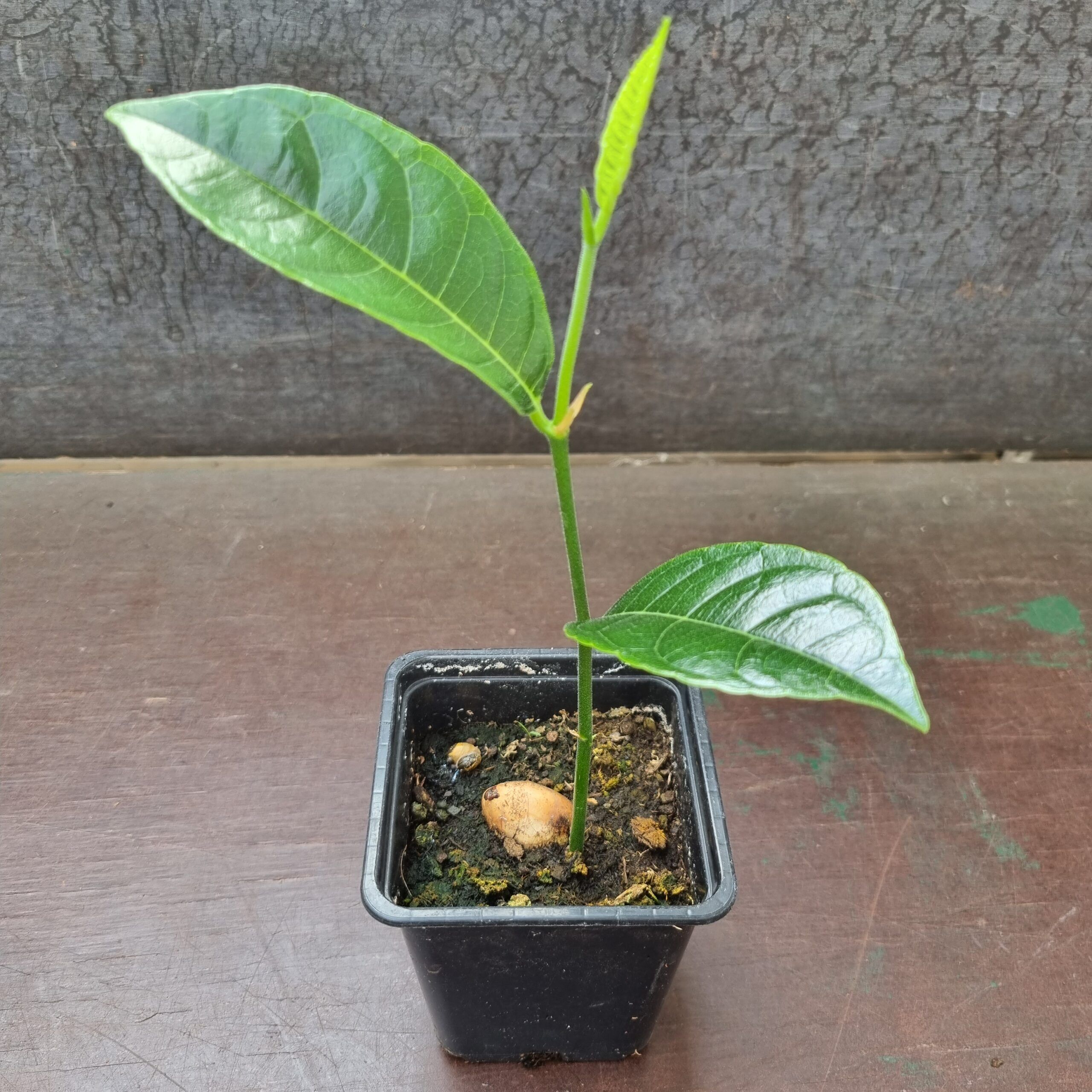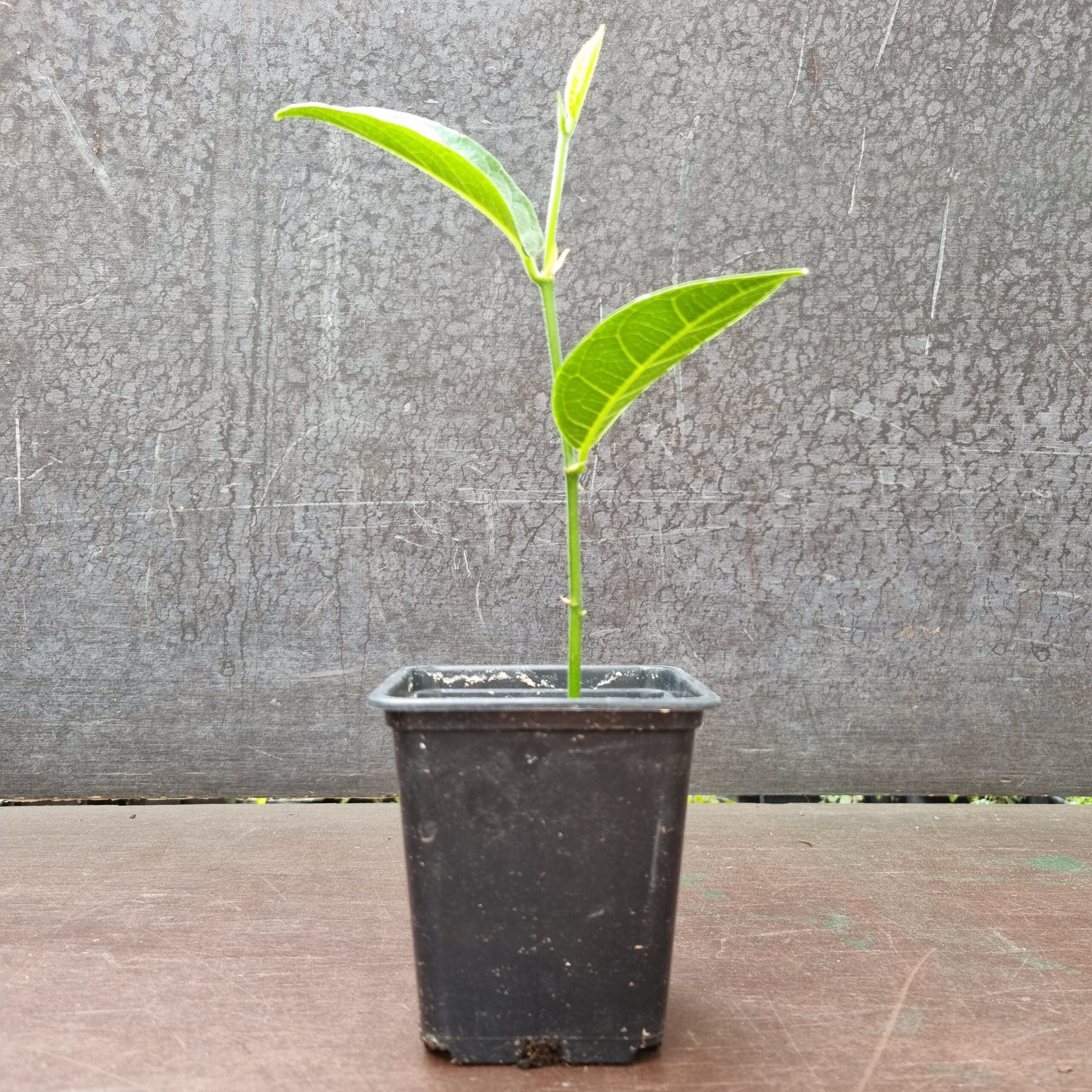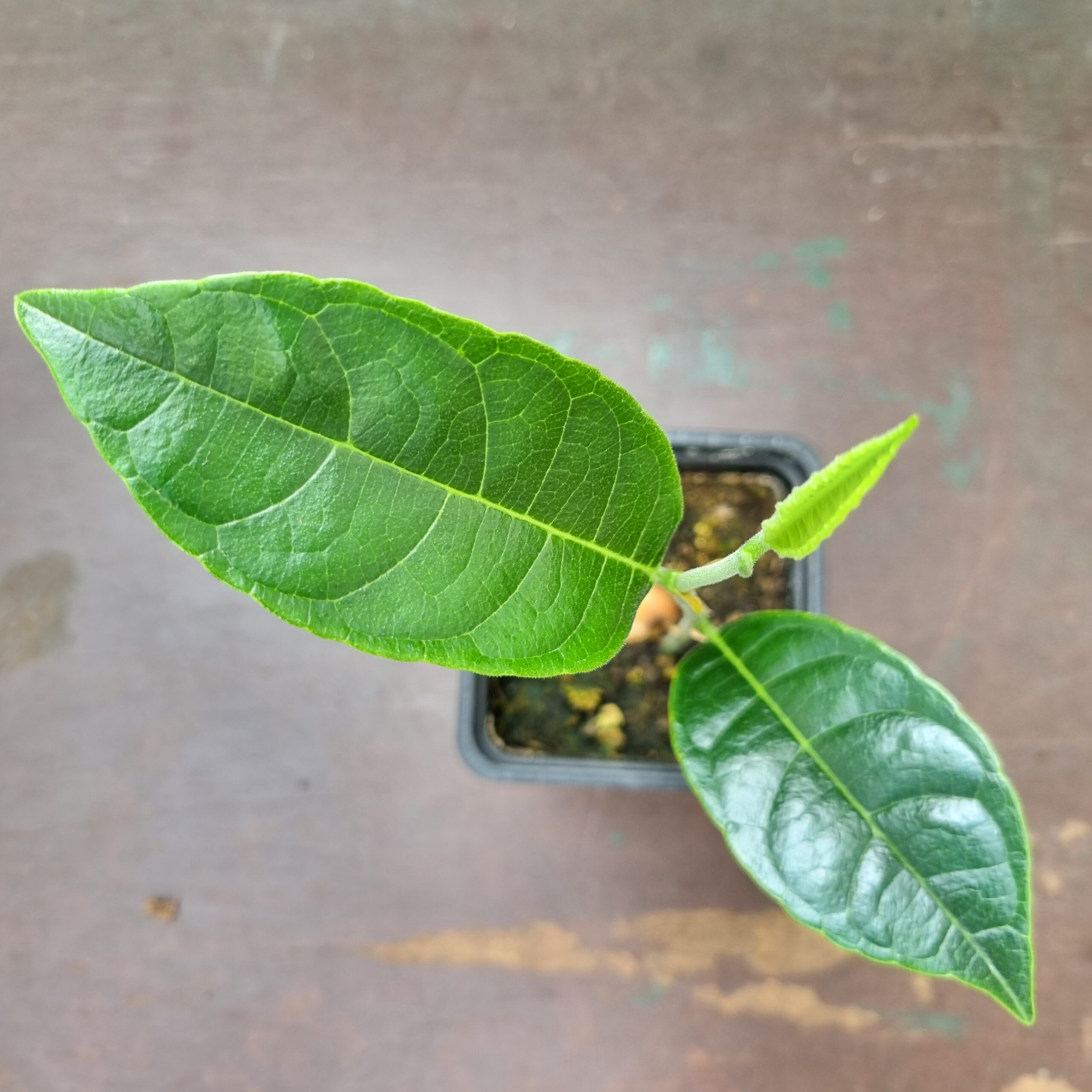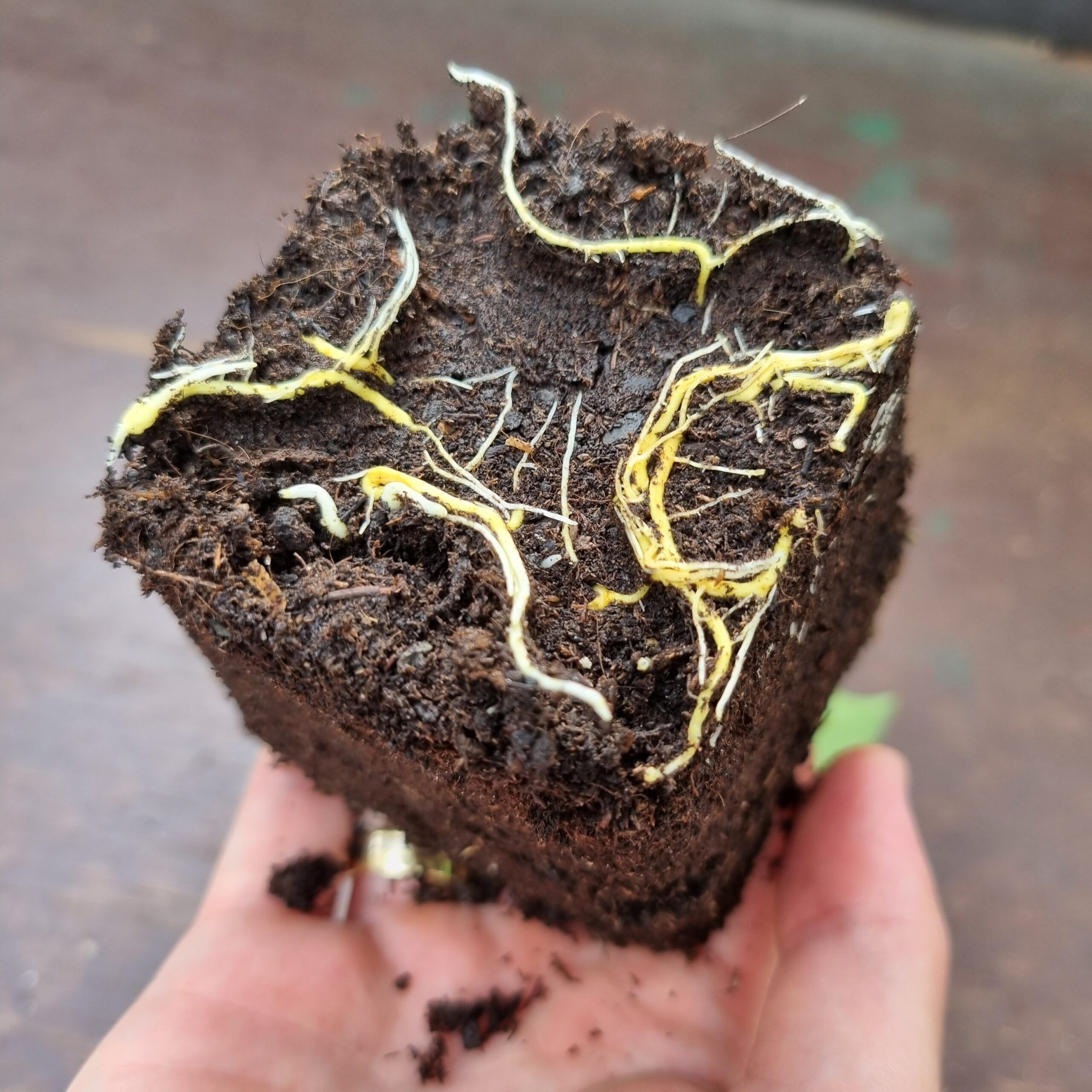1 happy Jackfruit tree – Artocarpus heterophyllus
€24.95
18 in stock

18 in stock

Fast EU shipping

Grown in our own nursery
The Jackfruit tree (botanical name Artocarpus Heterophyllus), also know as Jack tree, is a tropical tree that produces the largest fruits on the planet. You can find them in the jungles of southeast Asia and is also widely cultived in Asia, Australia, Africa and South America. The tree is also called Halasina Hannu(India), Nangka (Malaysia), kos (Sinhalese), ponas (Konkani), Palappalam (Tamil), Katahal (Hindi), and in some languages there are even different names for the different stages of the fruit.
Jackfruit

In general, when the fruit is ripe, it's sweet and can be eaten directly. When it's unripe, it's called young/green jackfruit, and it's mainly used for cooking in curries.
Westerners generally will find the jackfruit most acceptable in the full-grown but unripe stage, when it has no objectionable odor. The fruit cut into large chunks for cooking, the only handicap being its copious gummy latex which accumulates on the knife and the hands unless they are first rubbed with oil. The chunks are boiled in lightly salted water until tender, when the really delicious flesh is cut from the rind and served as a vegetable, including the seeds which, if thoroughly cooked, are mealy and agreeable.
If the jackfruit is allowed to ripen, the bulbs and seeds may be extracted outdoors; or, if indoors, the odorous residue should be removed from the kitchen at once. The bulbs may then be enjoyed raw or cooked (with coconut milk or otherwise); or made into ice cream, chutney, jam, jelly, paste, "leather" or papad, or canned in sirup made with sugar or honey with citric acid added.
The canned product is sometimes called "vegetable meat". The ripe bulbs are mechanically pulped to make jackfruit nectar or reduced to concentrate or powder.
By a method patented in India, the ripe bulbs are dried, fried in oil and salted for eating like potato chips. In Malaya, where the odor of the ripe fruit is not avoided, small jackfruits are cut in half, seeded, chilled, and brought to the table filled with ice cream.
The ripe bulbs, fermented and then distilled, produce a potent liquor. The seeds, which appeal to all tastes, may be boiled or roasted and eaten, or boiled and preserved in sirup like chestnuts. They have also been successfully canned in brine, in curry, and, like baked beans, in tomato sauce. They are often included in curried dishes. Roasted, dried seeds are ground to make a flour which is blended with wheat flour for baking.
Tender young fruits may be pickled with or without spices. Tender jackfruit leaves and young male flower clusters may be cooked and served as vegetables.
Other applications
In some areas, the jackfruit is fed to cattle. The Jackfruit tree is even planted in pastures so that the animals can avail themselves of the fallen fruits. Surplus jackfruit rind is considered a good stock food.
Jackfruit tree leaves: Young leaves are readily eaten by cattle and other livestock and are said to be fattening. In India, the leaves are used as food wrappers in cooking, and they are also fastened together for use as plates.
Latex: The latex serves as birdlime, alone or mixed with Ficus sap and oil. The heated latex is employed as a household cement for mending chinaware and earthenware, and to caulk boats and holes in buckets.
Wood: Jackwood is an important timber in former Ceylon (now Sri Lanka) and, to a lesser extent, in India; some is exported to Europe. It changes with age from orange or yellow to brown or dark-red; is termite proof, fairly resistant to fungal and bacterial decay, seasons without difficulty, resembles mahogany and is superior to teak for furniture, construction, turnery, masts, oars, implements, brush backs and musical instruments. Palaces were built of jackwood in Bali and Macassar.
From the sawdust of jackwood or chips of the heartwood, boiled with alum, there is derived a rich yellow dye commonly used for dyeing silk and the cotton robes of Buddhist priests. In Indonesia, splinters of the wood are put into the bamboo tubes collecting coconut toddy in order to impart a yellow tone to the sugar.

Sources
Morton, Julia. "Jackfruit". Center for New Crops & Plant Products, Purdue University Department of Horticulture and Landscape Architecture.
Additional information
| Weight | 0.3 kg |
|---|---|
| Dimensions | 32 × 10 × 9 cm |
Properties & Care
How to take care of a Jackfruit tree?
Like curry leaf trees, the Jackfruit tree is a tropical tree, and is not hardy in almost all parts of Europe. It should serve as a house tree indoors when temperatures reach freezing point at night. Since it’s a tropical tree, it should receive plenty of sunlight. As soon as winter is over and there’s no more frost at night, the jackfruit tree can be placed outside in a sunny spot.
The tree loves humidity, so it will benefit from the use of a humidity tray.
How to propagate a Jackfruit tree?
Propagation is done through seeds.
FAQ
Questions and answers
- Do I need to repot the tree when it arrives?
Answer: after a few weeks of acclimatization, you can repot it to bigger pot. The Jackfruit tree has big roots and likes a fairly big pot When you do repot, do so during the growing season (May-September). - What soil do I use for my Jackfruit tree?
Answer: Jackfruit tree thrive in a wide variety of soil types. You can use any regular good-quality potting mix. - Is fertilizer recommended?
Answer: Jackfruit trees don’t need fertilizers to thrive, but when in growing season they will do better when fertilized. If you choose to use a fertilizer, we recommend that you use a liquid fertilizer for your Jackfruit tree. - Why are the lower branches and leaves dying and falling off?
Answer: this is normal. As the Jackfruit tree grows, it will naturally shed old leaves and branches.
Shipping & Returns
Shipping
To ensure that it’s delivered in perfect condition, your Jackfruit tree will be shipped in custom plant mail-order cardboard packaging.
WARRANTY AND RETURNS
Despite the high quality of our products, it can occur that you receive a product that is not perfect. If that happens we’d like to provide you with a suitable solution as quickly as possible.
ALWAYS 2 YEARS WARRANTY
We are convinced of the quality of the products we offer. Therefore we always give 2 years guarantee on all your purchases.
14 DAY MONEY-BACK PERIOD
Curryelaftree.com operates a 14 day approval and inspection period for all online orders. This period starts when you have received the product. After 14 days the purchase agreement becomes final. During this period you should handle the product and packaging carefully, if reasonably possible. Try the product out to the extent necessary in order to decide whether you wish to keep it. The product can be vieuwd and reviewed, as you would do in a shop. When there is damage to the product or its packaging, this will be deducted from the return. When the product is used in this period, and now returned, the costs for use, such as cleaning or repair costs, will be deducted from the return. When you return a product within the 14 day money-back period, we are obliged to pay you the purchase price, including shipping and any debit or administration costs, back within 14 days from receiving your return.
DAMAGE UPON RECEIPT
All products are packaged safely and checked by Curryleaftree.com before shipping. If you nevertheless do receive a damaged product, please report the damage before returning the order.
RETURNS PROCEDURE
There are a number of reasons you may decide to return (a part of) your order. Read this information through carefully to avoid any misunderstandings and delays. If you wish to return a product, the method of shipment and the condition of the product must comply with our stated terms and conditions below.
Returns Form
For the return of a shipment contact us first. By filling in a form and sending it to us, you let us you know that you want to return your shipment. When we have received this form, we will start processing your return. You can always email us to discuss your return.
Return Shipment and Costs
The correct postal franking costs must always be paid for a return shipment. Packages not correctly franked or marked as returned subject to payment on delivery will not be accepted by us. Curryleaftree.com reimburses the postal costs after returning in case the return is a result of an mistake by Curryleaftree.com or when there is a defective product. If you are entitled to a refund of the shipping costs, we apply a maximum fee. You can also choose to bring the product back or exchange it at the Curryleaftree.com office. This is fast, easy and free of charge. The maximum fee for a return shipment is € 6,95 within the Netherlands, € 9,95 for Belgium and Germany, € 25.95 for the rest of Europe and € 29,00 for the rest of the world.
Return Address
Curryleaftree.com
Warranty and Returns
Tolweg 2W 3851 SK
Ermelo The Netherlands
Only logged in customers who have purchased this product may leave a review.





Reviews
There are no reviews yet.